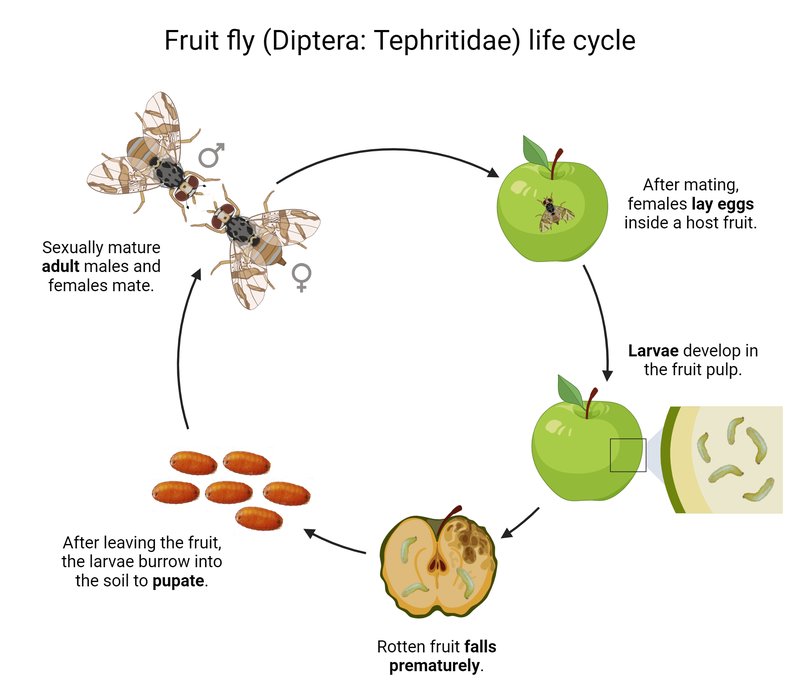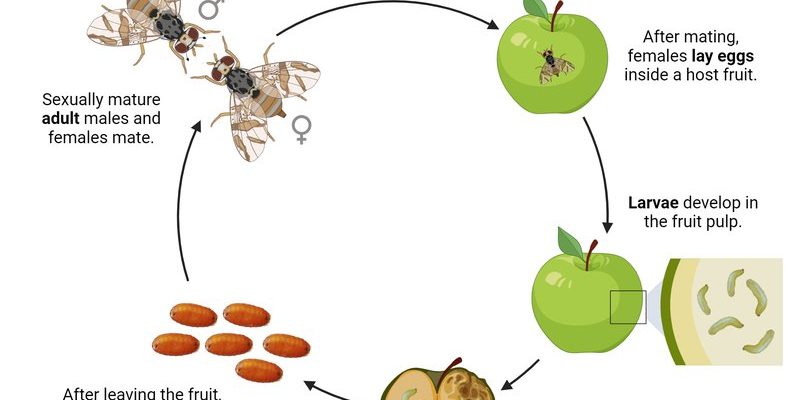
Fruit flies, scientifically known as *Drosophila melanogaster*, are one of the most studied organisms in biology. Their lifecycle is a perfect case study in rapid development, making them ideal for research. So, let’s dive into their lifecycle—from a tiny egg to a fully grown adult fruit fly—and explore what happens at each stage. You might just find yourself looking at these little critters with a newfound respect!
Stage 1: The Egg
The journey of a fruit fly begins as a tiny, almost invisible egg, which is about 0.5 mm long—less than the size of a pinhead! Female fruit flies are quite strategic; they lay their eggs on the surface of ripening or decaying fruit. Why? Because those delicious sugars provide the perfect food source for the larvae, known as maggots, once they hatch.
Each female can lay up to 400 eggs in her short life, which sounds like a lot, but that’s what nature intended to ensure survival. The eggs usually hatch in about 24 hours, but this can vary based on temperature and food availability. Imagine waiting for the big reveal—like opening a birthday present and finding tiny, wriggling maggots instead of toys!
Stage 2: The Larva
Once the eggs hatch, the real excitement begins! The larvae emerge and start feasting on the fruit—yes, they’re basically tiny eating machines at this stage. This phase lasts about 4 to 6 days, during which they grow rapidly, shedding their skin several times in a process called molting.
During this time, they can increase in size significantly, nearly tenfold! It’s almost like a time-lapse video of growth. They’re not just mindlessly munching away; these larvae are busy preparing for their next big transformation. During this eating spree, they accumulate nutrients that will fuel their future development into adult flies.
Stage 3: The Pupa
After the larval stage, fruit flies enter the pupal stage, which is kind of like an extended nap. The larvae find a safe spot, often beneath the fruit, where they can transform into pupae. This stage can last for about 4 to 6 days as well, during which a lot is happening behind the scenes.
Inside the pupa, the magic of metamorphosis occurs. The larval tissues break down and reorganize to form the adult fly. It’s like a superhero getting ready to emerge from a cocoon. You might be wondering what happens during this time—certainly not a boring wait! The pupal stage is when their wings, legs, and other adult features start developing.
Stage 4: The Adult
Finally, after days of transformation, the adult fruit fly emerges from the pupa. At first, they look a bit crumpled and fuzzy, and their wings will take a little time to dry out and expand. It’s like a baby bird taking its first flight, only in this case, it’s a fly figuring out how to buzz around.
Adult fruit flies are typically ready to mate within 24 to 48 hours after emerging. They come fully equipped with all the features they need to thrive: big red eyes, a body covered in tiny hairs, and of course, a keen sense of smell to locate food and mates. Their lifespan is pretty short, usually around 30 days, but in that time, they can contribute to the cycle by breeding and laying eggs of their own.
Factors Influencing Their Lifecycle
You might be surprised to know that temperature and food availability play huge roles in the lifecycle of a fruit fly. Warmer temperatures can speed up their development, while cooler temperatures can slow things down. Think of it like a race where the weather decides how fast the competitors can go.
In a perfect environment, under ideal conditions, a complete lifecycle can take as little as 8 to 10 days. But if it’s too cold or if food is scarce, the process can stretch out. This adaptability is part of what makes fruit flies so successful at thriving in various environments.
The Importance of Fruit Flies in Research
Now that we’ve explored their lifecycle, you might be wondering why fruit flies are so significant in scientific studies. These tiny insects are not just annoying; they play a pivotal role in genetics and biology research. Their lifecycle is rapid, which allows scientists to observe multiple generations in a relatively short time.
Researchers often use *Drosophila* to study genetics, behavior, and even human diseases. Since their genetic makeup shares similarities with humans, studying fruit flies can yield insights into genetic disorders. So, the next time you see a fruit fly buzzing around, remember that it’s helping scientists learn more about life itself!
The lifecycle of a fruit fly, from egg to adult, is a fascinating journey that happens faster than you might expect. Each stage is vital, contributing to their survival and ability to thrive in changing environments. Understanding this lifecycle not only helps us appreciate these tiny creatures but also highlights their importance in the scientific world.
So, whether you’re battling fruit flies in your kitchen or marveling at their incredible life story, remember that these little insects are doing more than just buzzing around. They’re making waves in the world of research and maybe giving us a lesson or two about resilience and adaptation. Next time you encounter a fruit fly, take a moment to acknowledge the complex life it leads!

